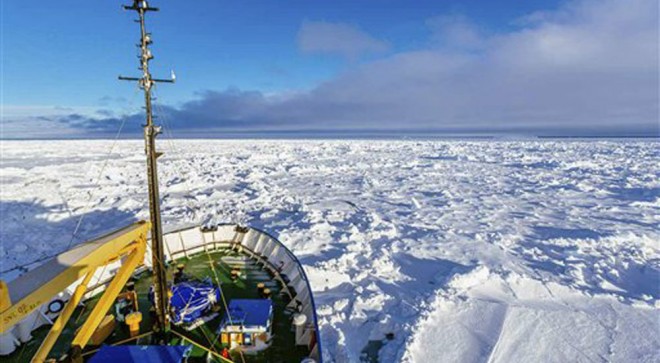
In this image provided by Australasian Antarctic Expedition/Footloose Fotography, Russian ship MV Akademik Shokalskiy is trapped in thick Antarctic ice 1,500 nautical miles south of Hobart, Australia, Friday, Dec. 27, 2013. The research ship, with 74 scientists, tourists and crew on board, has been on a research expedition to Antarctica, when it got stuck Tuesday after a blizzard’s whipping winds pushed the sea ice around the ship, freezing it in place. AP
SYDNEY— Passengers on a Russian research ship trapped in thick Antarctic ice faced an uncertain wait Sunday for one last ice breaking attempt with no guarantees of success.
The MV Akademik Shokalskiy has been marooned by heavy ice since Tuesday about 100 nautical miles east of the French Antarctic base Dumont d’Urville, with two icebreaking ships so far failing in attempts to reach it.
China’s Snow Dragon came tantalizingly close on Saturday, getting to within six-and-a-half nautical miles of the passenger vessel carrying 74 scientists, tourists and crew before impenetrable ice forced it to turn back.
The Australian government’s resupply ship Aurora Australis is now en route to make one final bid to free the icebound boat and is expected to reach the Akademik at 11pm Australian time (1200 GMT).
“It will then assess if it can make it through the ice to the Akademik Shokalskiy,” the Australian Maritime Safety Authority told AFP.
“If the Aurora Australis is not capable of getting through the ice, then we will look at utilizing the helicopter on board the Chinese-flagged vessel (the Snow Dragon) which AMSA’s Rescue Coordination Centre has tasked to remain in the vicinity.”
The Aurora Australis has the highest icebreaking rate of the three vessels initially sent to the Akademik’s rescue, which also included France’s L’Astrolabe, but there is no guarantee it will be able to reach the Russian ship.
The Australian icebreaker can cut ice up to 1.6 meters thick but the Akademik is estimated to be surrounded by ice of between three and four meters.
Aurora Australis captain Murray Doyle said Saturday that his vessel was not built to tackle ice thicker than three meters, likening it to driving a car into a brick wall.
Expedition co-leader Greg Mortimer said contingency plans had been made if the Australian vessel couldn’t reach them “in the next few days” to evacuate the Akademik, using the Snow Dragon’s helicopter to ferry passengers off the ice to other ships to return home “via the Ross Sea or (Australia’s) Casey (Antarctic) base.”
The call to abandon icebreaking efforts in favor of an air rescue would be made by the ships’ captains, particularly Doyle, he added.
“We’ll know I guess within 12 hours of the arrival of the Aurora Australis how that’s going to unfold, because if they arrive and the conditions are looking like the winds are going to be in our favor we’ve got a lot more on our side,” Mortimer told The Guardian.
Prevailing south-easterly winds have compressed the ice, making it more difficult to break, and Doyle will be hoping for a westerly which would ease pressure on the ice and boost cutting efforts.
He said the passengers would get off the ship but “what form that takes I don’t know”.
Despite the uncertainty of their plight the ship’s passengers were reported to be safe, well and in good spirits, with expedition co-leader Chris Turney and Guardian correspondent Alok Jha posting a jovial video online from the snowy deck.
“We’re still here, stuck at Cape de la Motte. Any passing ships do pay us a visit!” joked a fur-hatted Jha.
Passengers were passing their time by playing board games, watching films and taking walks on the ice to photograph passing penguins.
Others recorded video messages to family anxious for news back home.
“Just saying hi to let you know we’re going to be a little bit late, the ship’s stuck in a lot of really, really heavy ice and the Aurora Australis is coming in to get us,” Australian marine biologist Tracey Rogers said in a video update for her son and daughter.
The group, which includes Australians, Britons and New Zealanders, got stuck when unexpected weather forced their ship into heavy ice. An intense blizzard appears to have increased the buildup of ice around them.
They have been on board for three weeks and had intended to return to New Zealand by early January.

